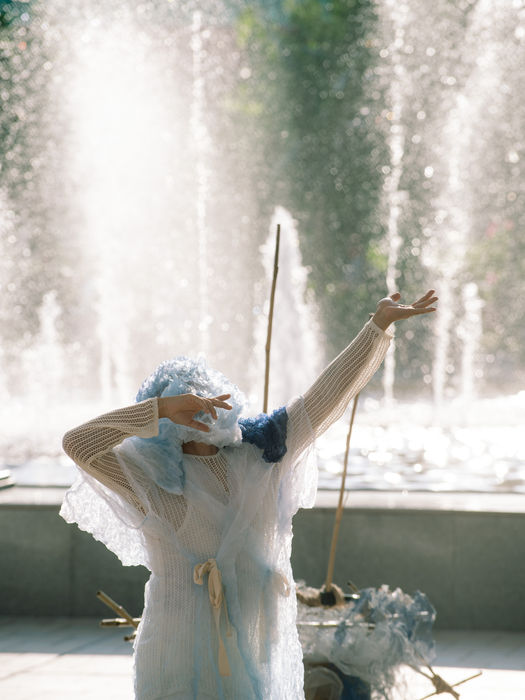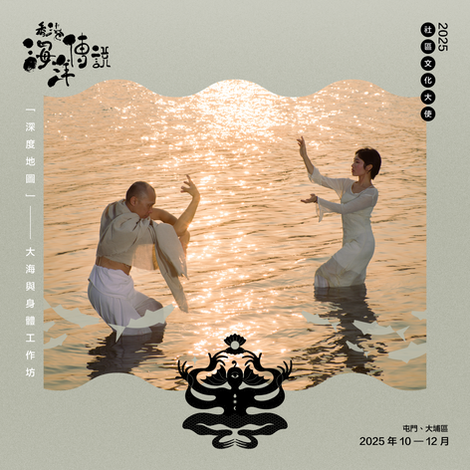"Beyond the Shore: Untold Stories of Salt and Pearl in Hong Kong (Tuen Mun and Tai Po Chronicles)" focuses on forgotten tales around the coastal areas of Tuen Mun and Tai Po. A performance incorporating sound, physical theatre and a fluid stage design, the project aims to create a poetic experience that engages in dialogue with local communities and histories. Curated and produced by Theatre Aether, artists Tomas Tse and Alysa Leung present and stage a unique art and theatre journey, based on their knowledge of local legends in the districts they live in, and research on Asian oceanic myths.
The project includes touring performances at local venues, movement and sound workshops, an exhibition, and sharing sessions with invited guests.
This autumn, rediscover bygone maritime legends of Hong Kong through sound and movement with Beyond the Shore’s artistic team.

Tuen Mun
Tuen Mun is in the western part of Hong Kong. It faces the estuary of the Pearl River and overlooks waters such as the Lingding Channel and the Jiuzhou Channel. Its name reflects its strategic importance of coastal defence: literally, the “garrison gate”. As early as the Tang Dynasty, the imperial court stationed troops in Tuen Mun not only to guard the South China Sea but also to protect coastal salt fields. Consequently, Tuen Mun is also the earliest named place on record in Hong Kong. Found in ancient texts, its name predates the name “Hong Kong” by several hundred years. Two renowned Tang Dynasty poets, Han Yu and Liu Yuxi, each wrote poems describing the scenery of Tuen Mun. Both mentioned the sea–“Clouds over Tuen Mun soar on high/ yet are engulfed in mirroring tides” and “Long days gather with no returning wind/ Relentless waves break into roaming drifts.” These lines illustrate Tuen Mun's close connection to the ocean.
Tai Po
Tai Po is located in the eastern part of Hong Kong. Legend has it that Tai Po used to be a dense jungle teeming with wild animals. People had to pass through it quickly with big strides to avoid the beasts, which gave rise to the nickname “Great Step”. However, according to research conducted by modern Chinese studies scholar Jao Tsung-i, the character for step (“步”) is interchangeable with other characters which refer to a ferry point or wharf (“埔”;“埗”). In fact, the name “Great Step” hints at the area’s connection to the sea.
Tolo Harbour, an inland sea within Tai Po, was historically known as the “Enchanted Pearl Pond" and served as an important pearl production region from the late Tang Dynasty until the early Ming Dynasty. After the pearl oysters were depleted, pearl production was replaced by ceramics. During its peak, the porcelain produced by the Tai Po Kiln was not only famous throughout southern China but was also exported to Southeast Asia, where it gained great popularity. Later, even as the ceramics industry declined, Tai Po maintained its significant status in eastern New Territories through the prosperity of its two major markets, Tai Po Old Market and Tai Wo Market.
Characters
A blazing Horned Beast storms through the dust of time. Red and hot, it only knows fury. Uprooted and cast into exile, the Beast faces an uncertain fate. In defiance it presses onwards, through ache and longing for home. Against all odds, it will survive.

The Horned Beast
A wise elder, the Oyster symbolises the silence of the oceans. Her few words are precious like pearls. A cradle to oceanic souls, she bears witness to the slow decay of life beneath the waves. Coastlines enfold in her ridged shell, and engrave dark histories of oppression.
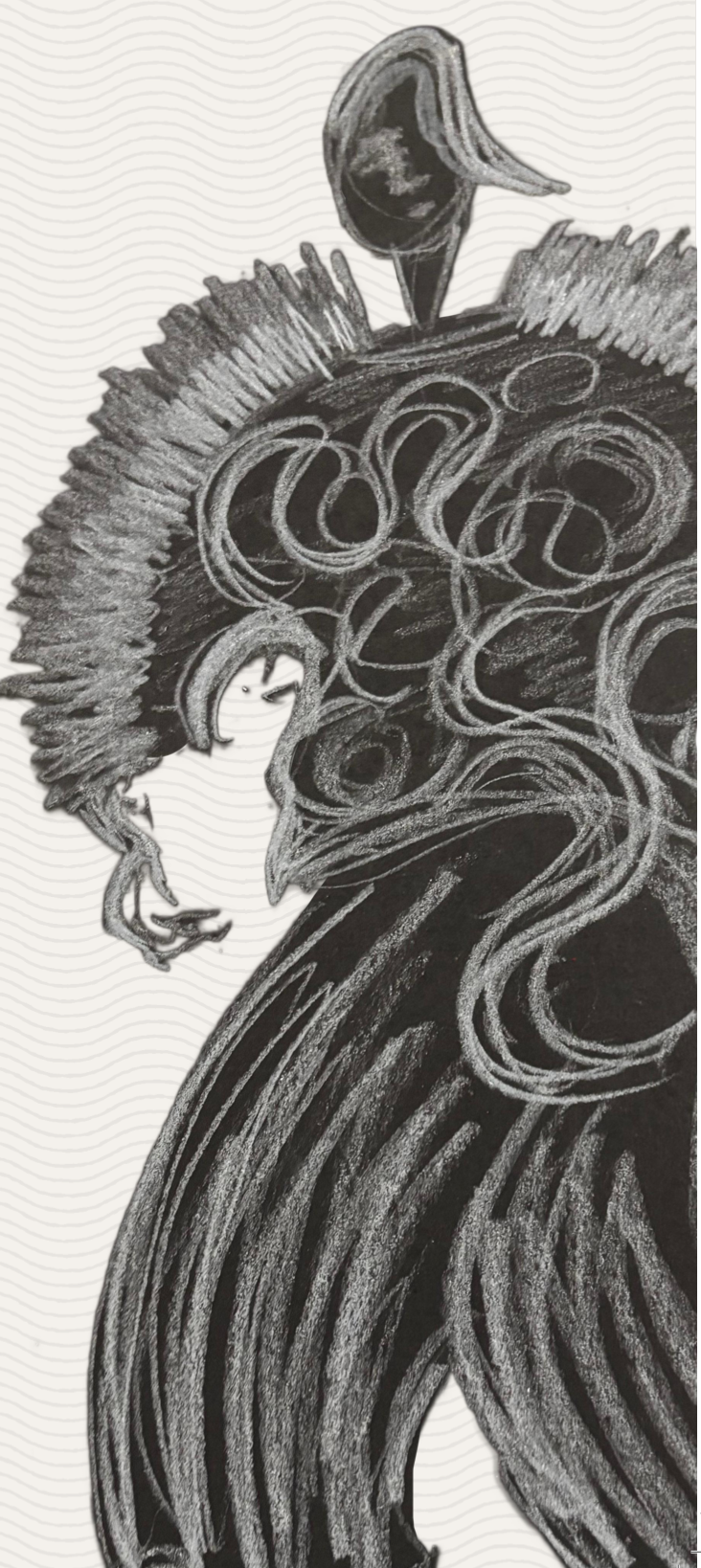
The Oyster
Like a jellyfish blooms that spawns and shapeshifts in the sea, it dances in the tides, softly adrift, playfully free. The Phantom Bloom embodies the spirit of dead oyster divers, breathless under the weight of hard labour. Its trailing tentacles sting with lost memories.
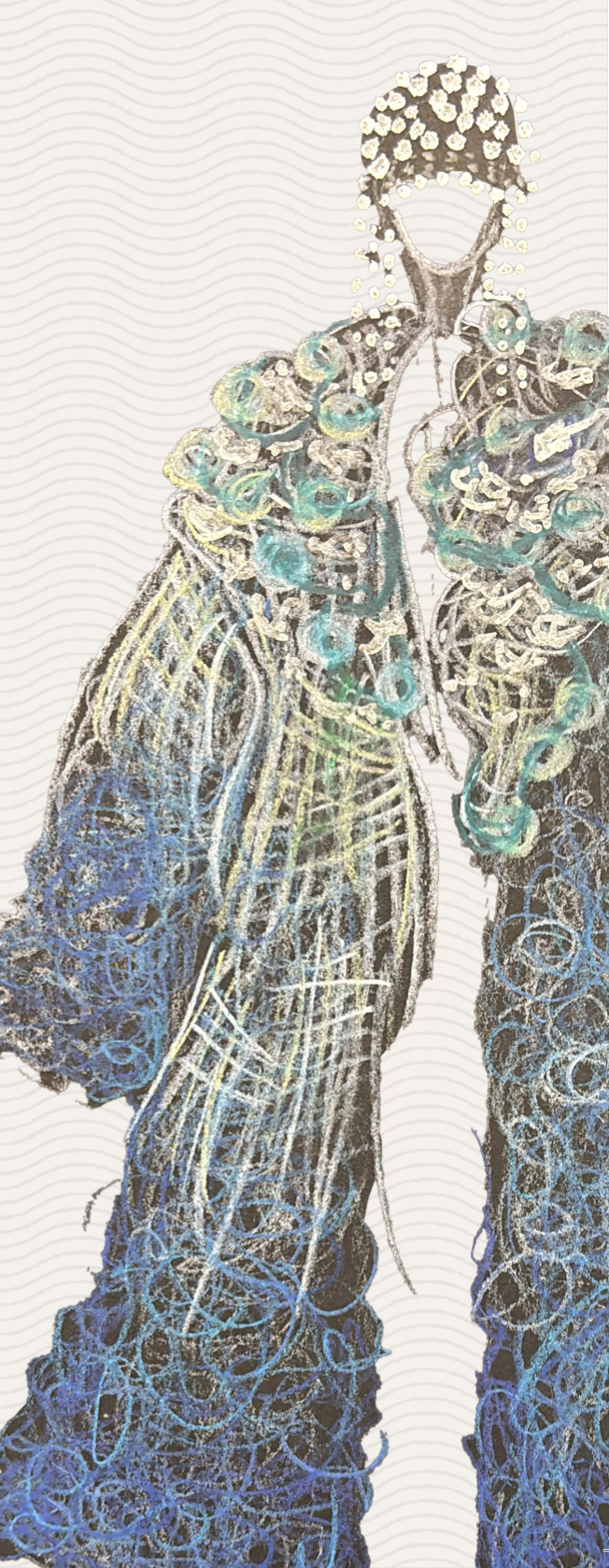
The Phantom Bloom
Between shores, two ferrymen travel far and wide to share legends of salty landscapes and seascapes. Carrying wisdom from the ancients on a psychic path of clairvoyance, they call forth ghostly memories and forgotten stories to unveil hidden histories everywhere they go.
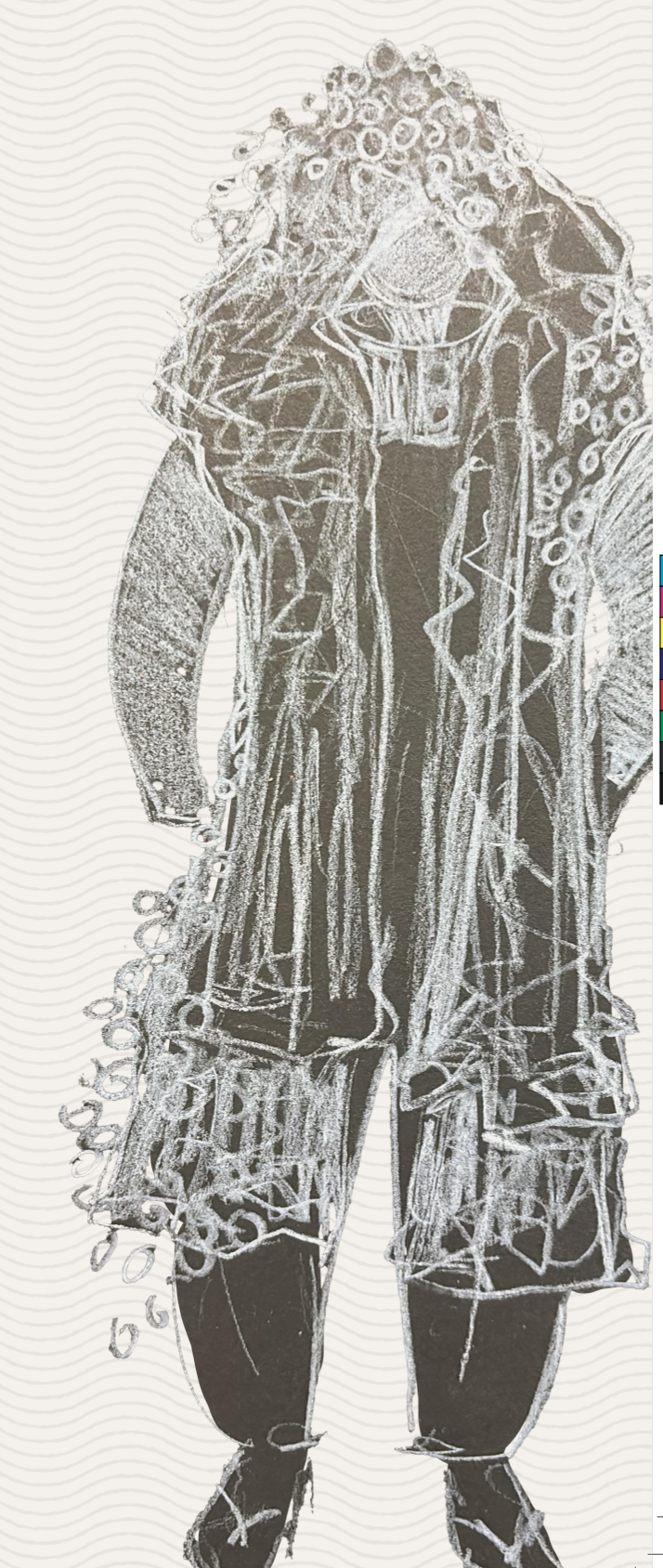
The Ferrymen
The mysterious priest and priestess appear, one a keeper of the sun, the other of the moon. Their music speaks the language of the gods, and carries the sacredness of rituals from generations past. Guardians of ancient lore, their songsmusic connects man, spirit, and god.
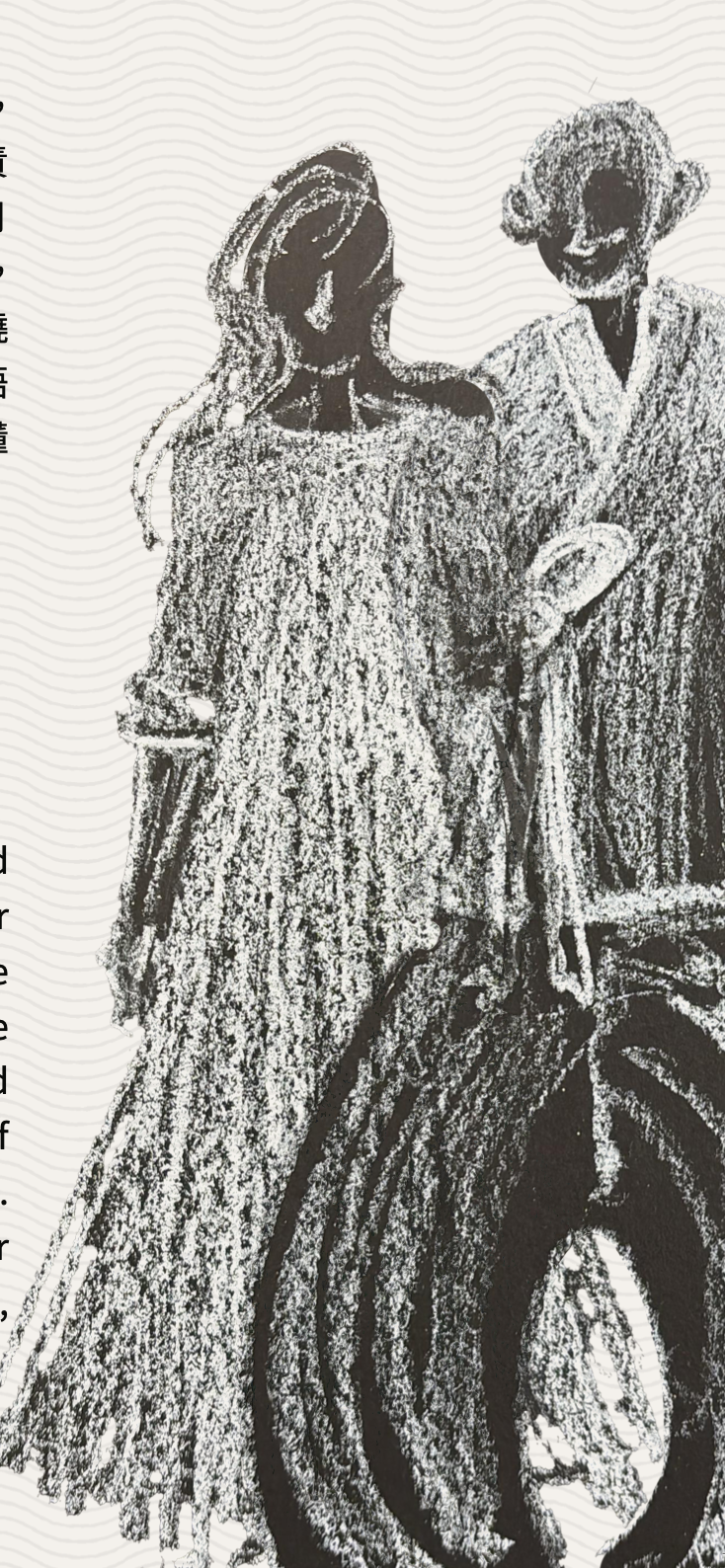
The Priest and Priestess of Sun and Moon
Historic Salt Industry in Hong Kong
Salt might seem like an ordinary everyday item, but in ancient times it was considered very valuable. The amount of salt that a society could produce often affected its stability. Because of this, numerous regimes across the world historically controlled the salt trade. Salt also played an important role in Hong Kong’s history. For example, East Kowloon was home to the Guanfu Salt Farm during the Song and Yuan dynasties. By the Ming dynasty, it became one of the four major salt farms in San On County (which covered roughly Hong Kong and Shenzhen today). Tuen Mun was also an important salt-producing area—in 1945, an English record mentions Hong Kong’s three remaining salt pans as Tai O, Sha Tau Kok, and Tuen Mun at the foot of Castle Peak.
Salt production sounds deceptively simple—you just need seawater and sunlight. But in reality, the process is hard work. Salt workers channel seawater into large storage ponds where it evaporates into brine, which is highly-concentrated seawater. This brine is then directed into crystallisation ponds, where it sits in the sun for one to two weeks until fully evaporated. To ensure that the salt crystals form evenly, workers first spread a layer of fine sand at the bottom of the ponds, which they then level off with rakes. With even sunlight, the brine dries and forms clean, uniform, and beautiful salt grains.
Under the hot sun, workers spend long hours raking, walking, and carrying heavy loads. Their sweat drips into salt pans and mixes with seawater and brine. Every grain of salt literally carries the story of their physical exertion and dedication. This powerful image has inspired our team’s creative work.

Creative Inspiration
The Coastal Evacuation Order in 17th Century
After the Manchurians established the Qing court in the North in 1644, Ming loyalist forces led by Zheng Chenggong (Koxinga) continued to hold out in coastal areas, determined to resist Qing and restore the Ming Government. To prevent coastal residents from aiding or joining Ming loyalists, the Qing court implemented the Coastal Evacuation Order. Residents along the coast from Shandong to Guangdong were forced to move inland by 30 Chinese miles (li), roughly equivalent to 15 km. This order had a profound impact on Hong Kong’s history. Fertile farmlands and estates that people worked hard to cultivate were abandoned overnight. Once-bustling markets were overtaken by weeds and forests, as if everything had been reclaimed by wilderness.
The Coastal Evacuation Order set forth stories of diasporic separation and reunion, which has inspired our team’s creative work.
Historic Pearl Harvest in Hong Kong
Today, she is known as Tolo Harbour. Then, she was called Tai Po Hoi (Great Step Sea). Once upon a time, she bore an exquisite name: Enchanted Pearl Pond, because her seabed was once a treasure trove of pearls.
During the Five Dynasties and Ten Kingdoms period in the 10th century, the Southern Han court established a special garrison at Tai Po Hoi to go after the pearls. They stationed troops to supervise local pearl divers and to ensure a sufficient supply. The pearl retrieval process was very dangerous. Divers would tie stones to their bodies to increase weight before plunging to the seabed in search of pearl-bearing oysters. Many divers drowned from exhaustion. At the time, the Southern Han royalty was known for its extravagance. Even palace interiors were adorned with jewels, and the aristocracy had an insatiable craving for pearls. Under the court's pressure, countless bodies sank to the seabed in the quest for lustrous, smooth pearls. A Song Dynasty poet even lamented the pearl divers’ suffering, "Wandering souls beneath the water still weep for one another."
Treasures from that era may now reside in museum collections, glowing with soft radiance behind glass cases. and vVisitors who pause before them may catch a glimpse of past opulence and imagine the luxurious lives of their former owners. But what of the pearl divers? Nameless and absent from historical record, their lives are forever lost to the depths of the sea. Our creative team seeks to honour these forgotten individuals through performance and music, by giving voice and form to their memory.
Tuen Mun: Buddhist Monk Pui To
A foreign monk left a lasting mark on the history of Tuen Mun—Master Pui To. According to some ancient records, he was from India. Renowned for his profound meditative states and extraordinary spiritual power, he was said to cross rivers using only a wooden cup as his boat. He became known as Master “Pui To”, literally, to cross with a cup. Legend has it that he eventually settled in Tuen Mun’s Castle Peak, making him the first to bring Buddhism to Hong Kong. The humble hut he built there later developed into the renowned Castle Peak Monastery. One may wonder—when Master Pui To first gazed upon the steep ridges of Castle Peak, did he recall India’s Vulture Peak, the sacred site where Buddha once taught?
Tuen Mun: Ghost Stories from Mouse Island
Mouse Island was originally an uninhabited island in Castle Peak Bay. The government developed Tuen Mun into a New Town in the 1970s, and reclaimed land from the sea. Consequently, Mouse Island was incorporated into Tuen Mun. Legend has it that this island was once a place where local fisherfolk buried infants who died prematurely. During the initial development phase, survey personnel unearthed skeletal remains time and again. Not only was this reported in newspapers at the time, rumours of paranormal activity also haunt the area. Today, what was once Mouse Island is a children’s playground. Nautically themed, a large play ship stands silently there, as if evoking memories of its past.
Tai Po: Tang Sze-mang
During the Ming and Qing dynasties, piracy was rampant across oceans, especially in the South China Sea. The waters of Hong Kong—strategically located at the mouth of the Pearl River—were no exception. Local gazetteers preserved many pirate tales, including the story of Tang Sze-mang, colloquially known as the filial son of Tai Po. According to legend, during the Longqing reign of the Ming dynasty (1567-1572), pirates plundered and took hostages for ransom in Tai Po. Among those taken was Tang Sze-mang’s father. Out of filial devotion, Tang Sze-mang boarded the pirate ship alone, begging to exchange his life for his father’s. Once his father was released, Tang Sze-mang leapt into the sea, and sacrificed himself in his place. In memory of his virtuous act, the Tang clan later built the “Shrine of the Filial Son” in the old Tai Po Market. Though the shrine no longer exists, some believe its site was likely in the vicinity of the present-day Tin Hau Temple. Today, Tang Sze-mang’s spirit tablet is still enshrined at the Tang Chung Ling Ancestral Hall, where it continues to receive offerings.

"The Untold Stories of Salt and Pearl" Interactive Community Theatres

On the shores of Tolo Harbour, the lights shine brightly, and the bustling city of Tuen Mun thrives with prosperity. But did you know that these places were once the production sites for pearls and salt?
In the past, the waters of Tai Po were a major pearl harvesting hub in South China, while Tuen Mun flourished with a thriving salt-making industry. These two precious products were even considered imperial tributes! Yet, behind their great value lies the untold stories of the labour and sacrifices of those who produced them.
Produced by Theatre Aether, "The Untold Stories of Salt and Pearl" Interactive Community Theatres draws inspiration from the maritime history of Tai Po and Tuen Mun. The creative team weaves together elements of mythology, historical records, urban legends, and folklore, using music and theatre as mediums to craft delicate connections between past legends and contemporary community life. Through sound and physical expression, the performance unfolds as a poetic ode to labourers and the environment.
Let us take imagination as our vessel to traverse the barriers of time and space—rediscovering the buried legends of salt and pearls beneath the concrete and steel.
2025.10.25 (Sat) 1600 Tuen Mun Civic Square
2025.10.26 (Sun) 1200 Tai Po Central Town Square
2025.10.26 (Sun) 1600 Tai Wo Plaza (Square)
2025.11.1 (Sat) 1200 Tuen Mun Yan Oi Town Square
2025.11.1 (Sat) 1600 Yau Oi Plaza
2025.11.9 (Sun) 1600 Sam Shing Estate Stage
2025.11.15 (Sat) 1600 Tai Po Waterfront Park
2025 11.22 (Sat) 1200 Tai Po Arts Centre
photo credit: Maximilian Cheng
Community Workshop Series
Presenter: Theatre Aether
Concept/ Choreographer/ Performer: Tomas Tse, Alysa Leung
Live Musician: Ding, Kateryna Gavrylova
Dramaturg and Translator: Evelyn Wan
Stage and Costume Designer: Tiff Ho
Researcher and Exhibition Editor: Gabriel Lee
Graphic Designer: VVN
Videographer: Maximillian Cheng
Project Coordinator: Lavinia Fu
Research/ creative support: If Time’s Limited



